High-Efficiency high-gain 2.4 GHz class-b power amplifiers in 0.13 µm cmos for wireless communications
In today’s communication age, almost
every portable device has some sort of
transmitter and receiver allowing it to connect
to a cellular network or available Wi-Fi
networks. CMOS high-efficiency PAs are
among the most challenging components in
transmitter design for wireless communications,
automotive radar and other applications. The
main purpose of a PA design is to provide
sufficiently high output power, while another
very important target is to achieve high
efficiency. There are several obstacles which
make the implementations of a PA very
difficult in CMOS technology. The use of
submicron CMOS increases the difficulty of
implementation due to technology limitations
such as low breakdown voltage and poor
transconductance. The linearity and power
efficiency are lower than other
technologies.However, with the trend of lower
power transmitters in the next generation,
implementation of CMOS PAs with good
efficiencies are becoming realistic despite
steadily declining field-effect transistor (FET)
breakdown voltages. To improve the efficiency
of the PAs, the trend is toward using class-B or
class-AB topologies, which are more energy
efficient compared to the class-A ones [2].
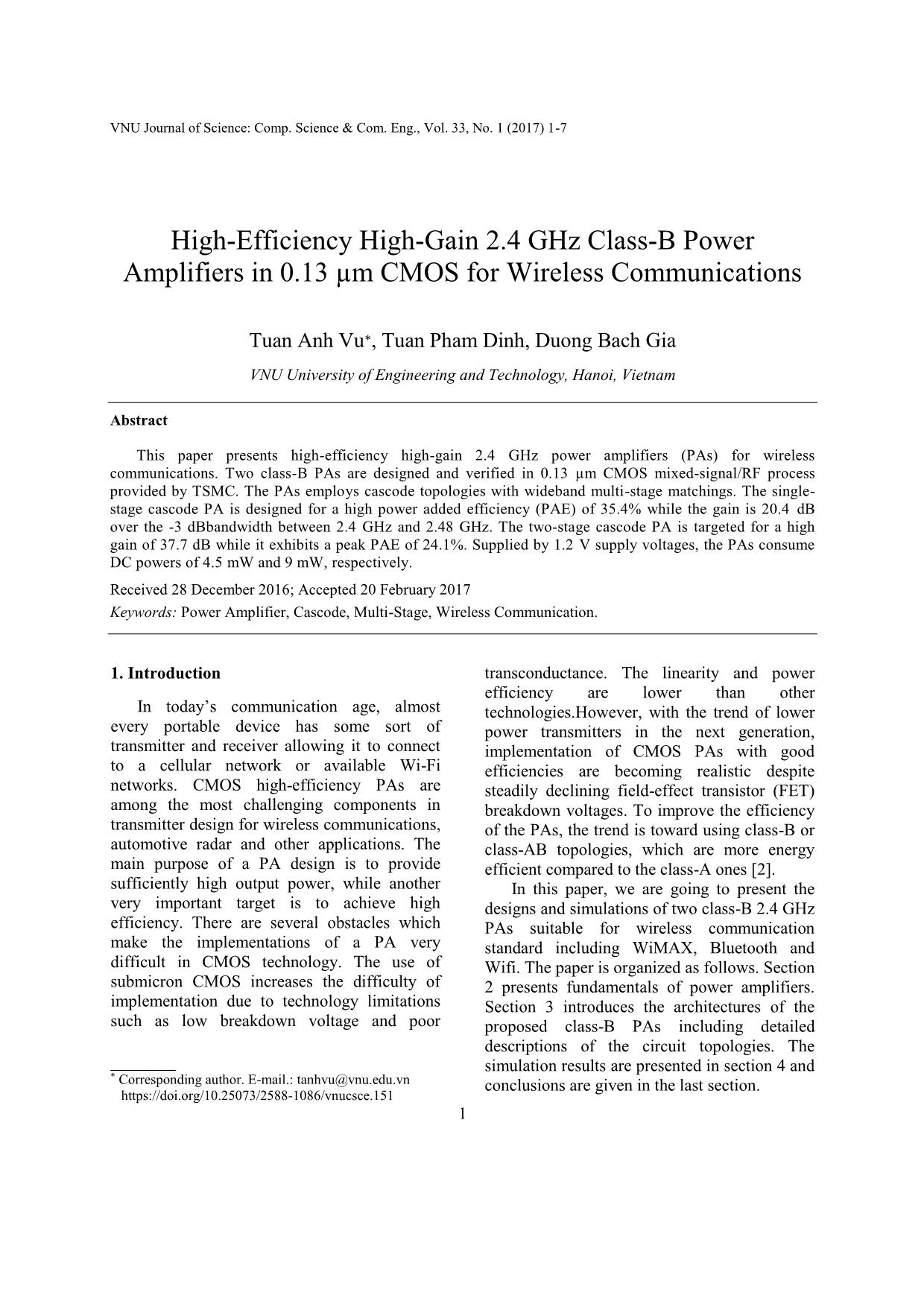
Trang 1
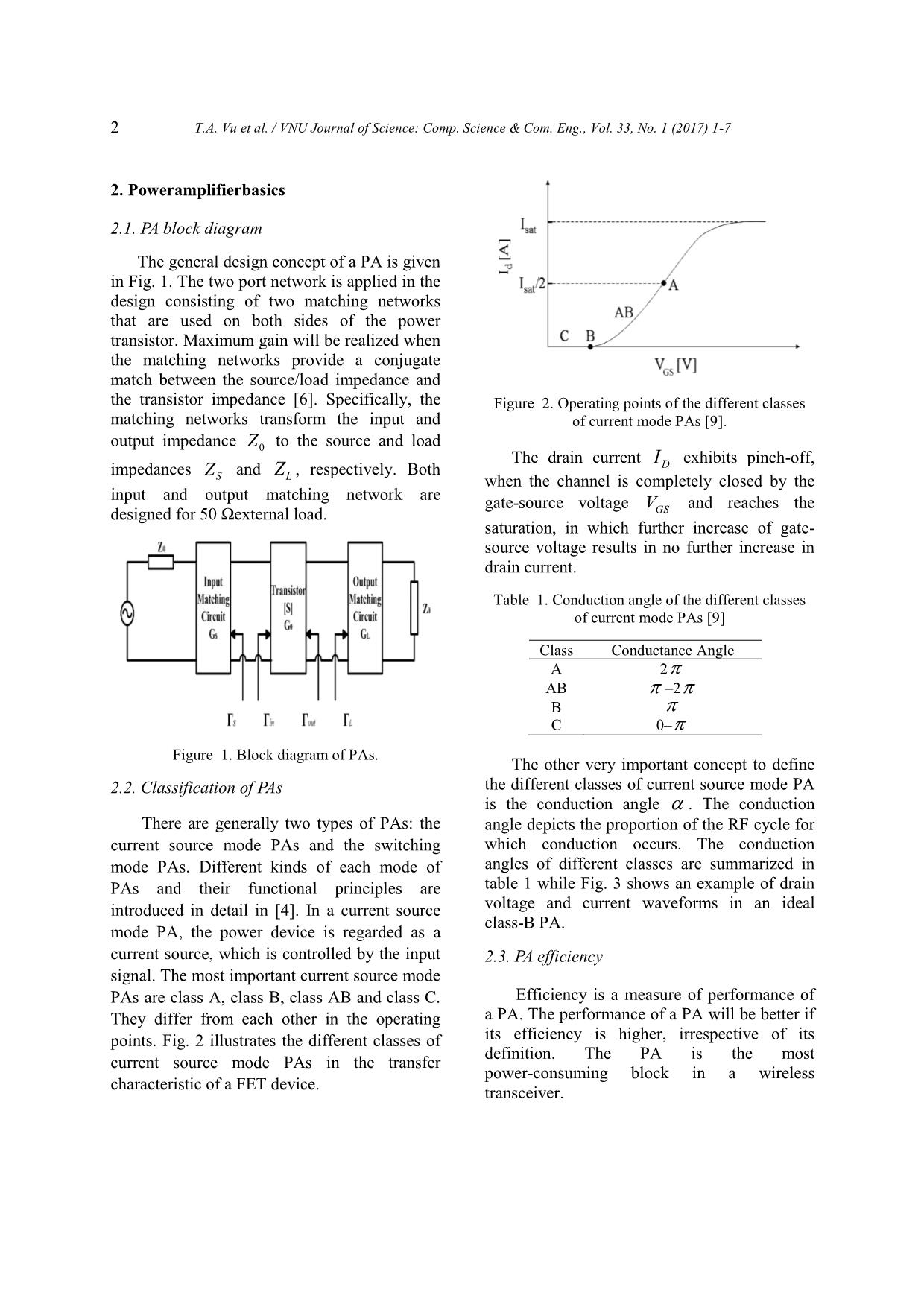
Trang 2
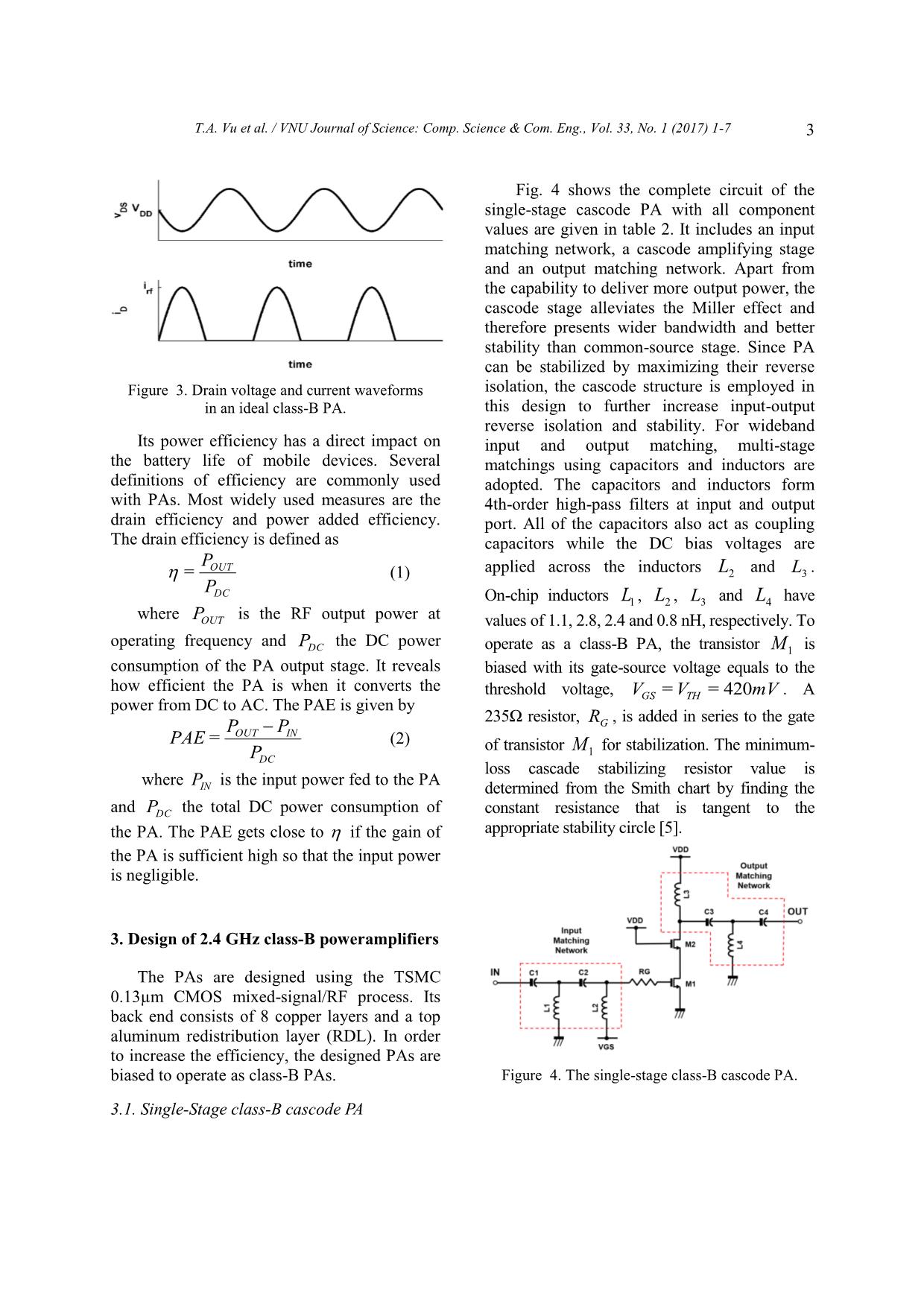
Trang 3
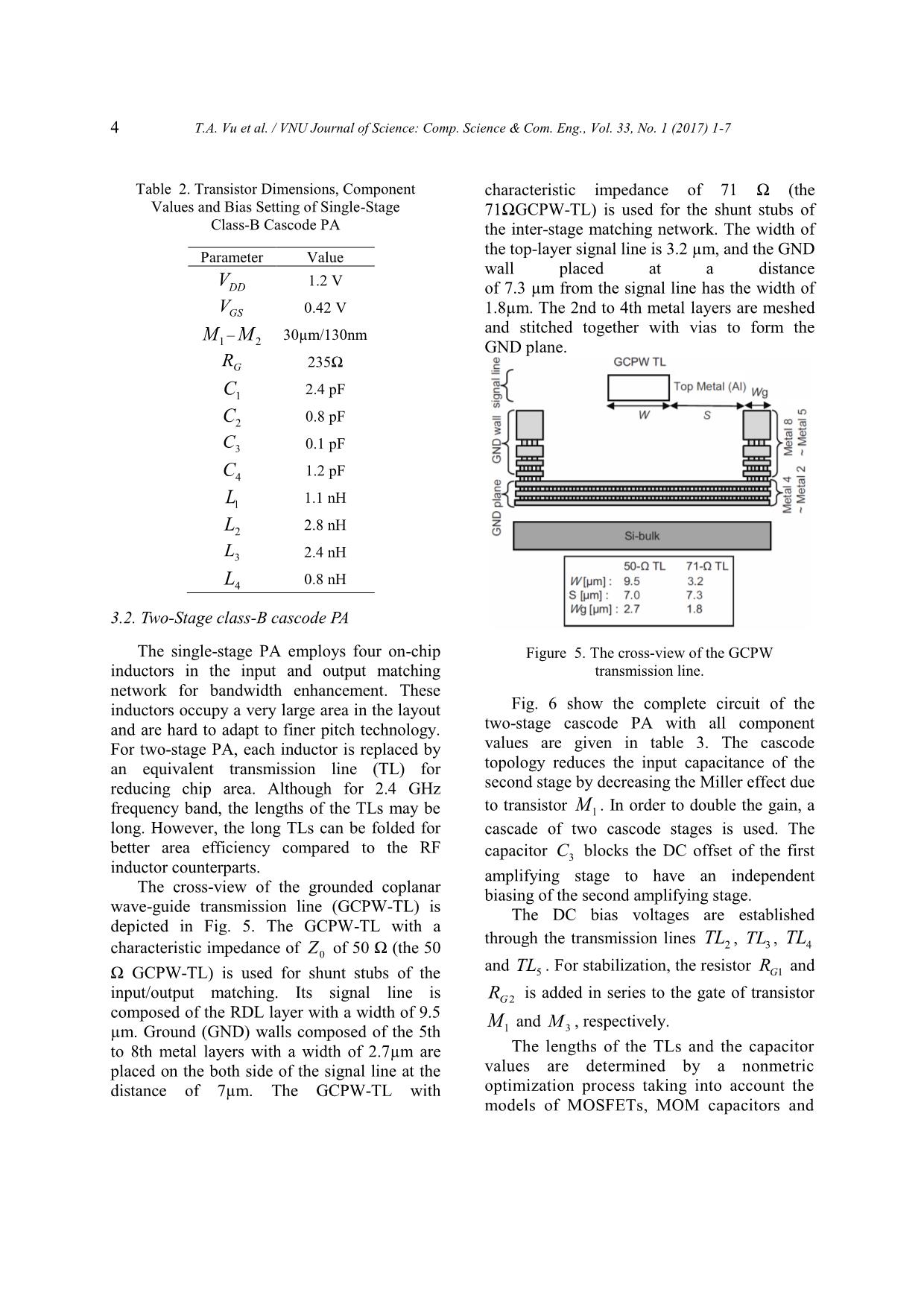
Trang 4
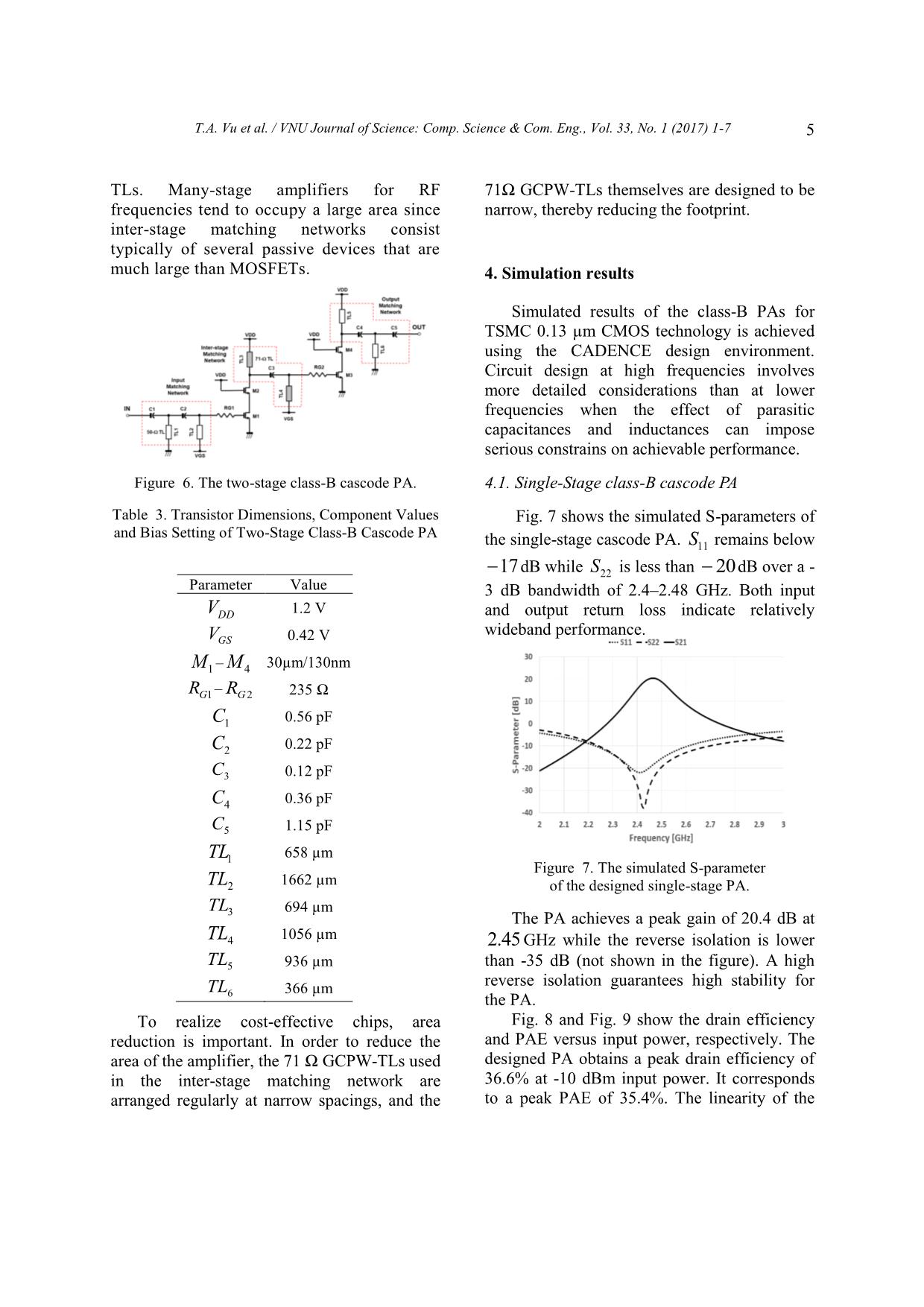
Trang 5
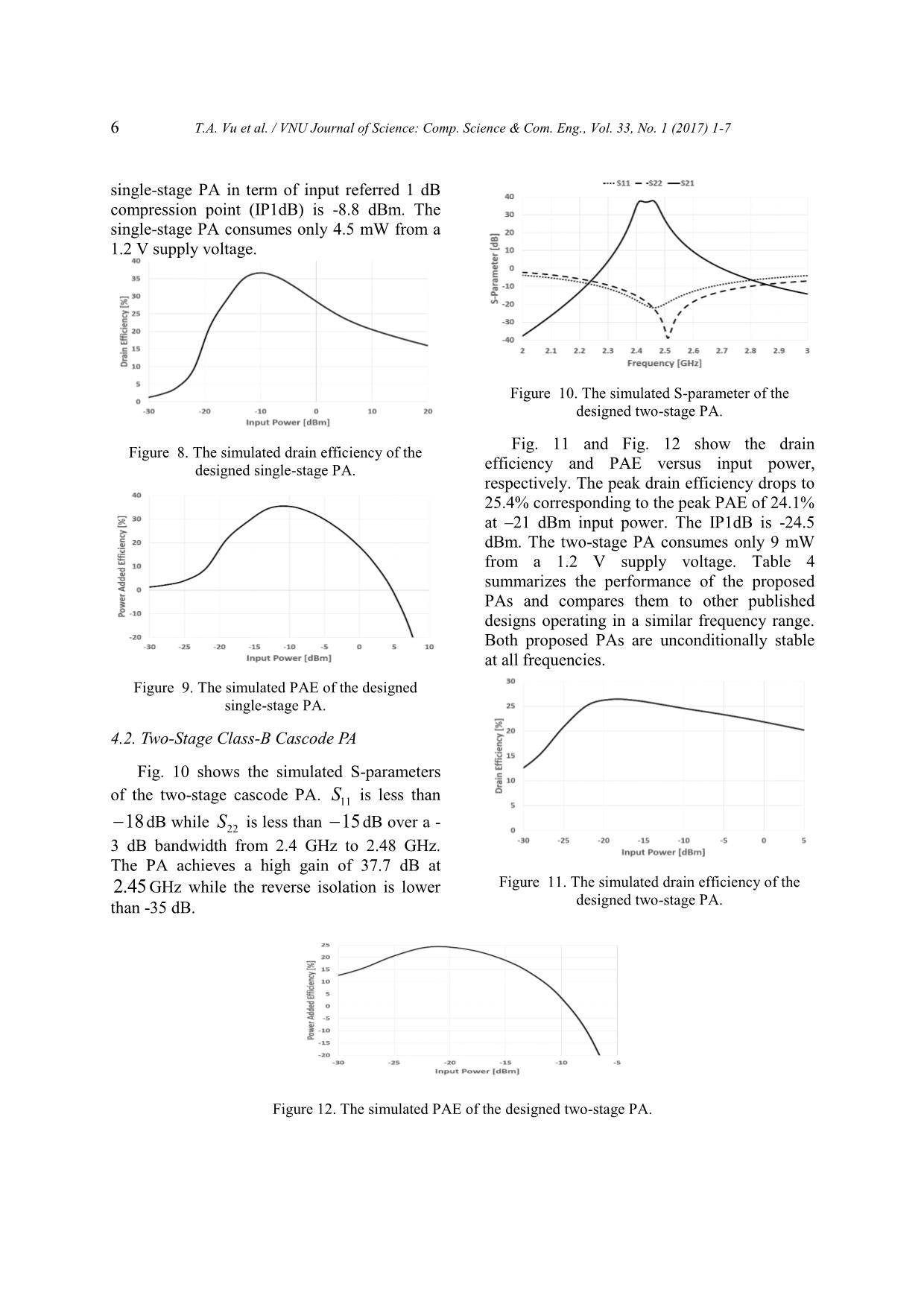
Trang 6
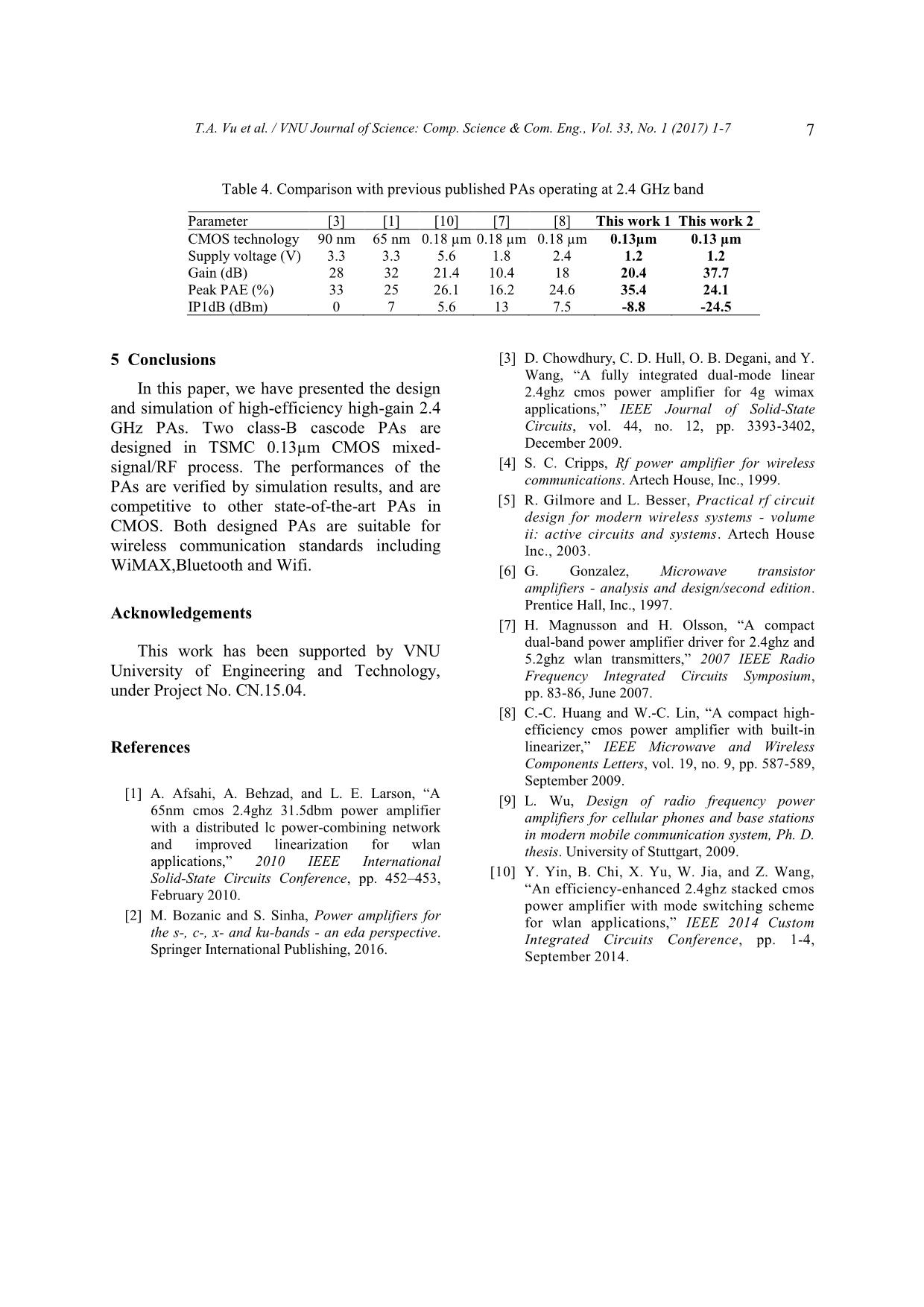
Trang 7
Tóm tắt nội dung tài liệu: High-Efficiency high-gain 2.4 GHz class-b power amplifiers in 0.13 µm cmos for wireless communications
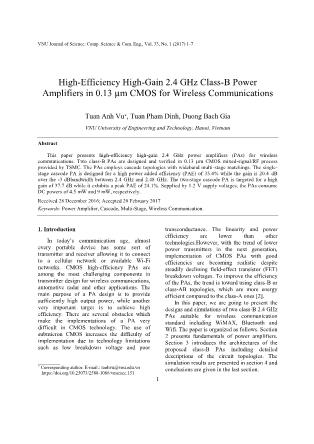
lifiers. implementation due to technology limitations Section 3 introduces the architectures of the such as low breakdown voltage and poor proposed class-B PAs including detailed descriptions of the circuit topologies. The _______ simulation results are presented in section 4 and * Corresponding author. E-mail.: tanhvu@vnu.edu.vn conclusions are given in the last section. https://doi.org/10.25073/2588-1086/vnucsce.151 1 2 T.A. Vu et al. / VNU Journal of Science: Comp. Science & Com. Eng., Vol. 33, No. 1 (2017) 1-7 2. Poweramplifierbasics 2.1. PA block diagram The general design concept of a PA is given in Fig. 1. The two port network is applied in the design consisting of two matching networks that are used on both sides of the power transistor. Maximum gain will be realized when the matching networks provide a conjugate match between the source/load impedance and the transistor impedance [6]. Specifically, the Figure 2. Operating points of the different classes matching networks transform the input and of current mode PAs [9]. output impedance Z0 to the source and load The drain current I exhibits pinch-off, impedances Z and Z , respectively. Both D S L when the channel is completely closed by the input and output matching network are gate-source voltage V and reaches the designed for 50 Ωexternal load. GS saturation, in which further increase of gate- source voltage results in no further increase in drain current. Table 1. Conduction angle of the different classes of current mode PAs [9] Class Conductance Angle A 2 AB –2 B C 0– Figure 1. Block diagram of PAs. The other very important concept to define 2.2. Classification of PAs the different classes of current source mode PA is the conduction angle . The conduction There are generally two types of PAs: the angle depicts the proportion of the RF cycle for current source mode PAs and the switching which conduction occurs. The conduction mode PAs. Different kinds of each mode of angles of different classes are summarized in PAs and their functional principles are table 1 while Fig. 3 shows an example of drain introduced in detail in [4]. In a current source voltage and current waveforms in an ideal class-B PA. mode PA, the power device is regarded as a current source, which is controlled by the input 2.3. PA efficiency signal. The most important current source mode PAs are class A, class B, class AB and class C. Efficiency is a measure of performance of They differ from each other in the operating a PA. The performance of a PA will be better if points. Fig. 2 illustrates the different classes of its efficiency is higher, irrespective of its definition. The PA is the most current source mode PAs in the transfer power-consuming block in a wireless characteristic of a FET device. transceiver. T.A. Vu et al. / VNU Journal of Science: Comp. Science & Com. Eng., Vol. 33, No. 1 (2017) 1-7 3 Fig. 4 shows the complete circuit of the single-stage cascode PA with all component values are given in table 2. It includes an input matching network, a cascode amplifying stage and an output matching network. Apart from the capability to deliver more output power, the cascode stage alleviates the Miller effect and therefore presents wider bandwidth and better stability than common-source stage. Since PA can be stabilized by maximizing their reverse Figure 3. Drain voltage and current waveforms isolation, the cascode structure is employed in in an ideal class-B PA. this design to further increase input-output reverse isolation and stability. For wideband Its power efficiency has a direct impact on input and output matching, multi-stage the battery life of mobile devices. Several matchings using capacitors and inductors are definitions of efficiency are commonly used adopted. The capacitors and inductors form with PAs. Most widely used measures are the 4th-order high-pass filters at input and output drain efficiency and power added efficiency. port. All of the capacitors also act as coupling The drain efficiency is defined as capacitors while the DC bias voltages are POUT = (1) applied across the inductors L2 and L3 . PDC On-chip inductors L1 , L2 , L3 and L4 have where POUT is the RF output power at values of 1.1, 2.8, 2.4 and 0.8 nH, respectively. To operating frequency and P the DC power DC operate as a class-B PA, the transistor M1 is consumption of the PA output stage. It reveals biased with its gate-source voltage equals to the how efficient the PA is when it converts the threshold voltage, VGS = VTH = 420mV . A power from DC to AC. The PAE is given by 235Ω resistor, R , is added in series to the gate P P G PAE = OUT IN (2) of transistor M1 for stabilization. The minimum- PDC loss cascade stabilizing resistor value is where P is the input power fed to the PA IN determined from the Smith chart by finding the and PDC the total DC power consumption of constant resistance that is tangent to the the PA. The PAE gets close to if the gain of appropriate stability circle [5]. the PA is sufficient high so that the input power is negligible. 3. Design of 2.4 GHz class-B poweramplifiers The PAs are designed using the TSMC 0.13µm CMOS mixed-signal/RF process. Its back end consists of 8 copper layers and a top aluminum redistribution layer (RDL). In order to increase the efficiency, the designed PAs are biased to operate as class-B PAs. Figure 4. The single-stage class-B cascode PA. 3.1. Single-Stage class-B cascode PA 4 T.A. Vu et al. / VNU Journal of Science: Comp. Science & Com. Eng., Vol. 33, No. 1 (2017) 1-7 Table 2. Transistor Dimensions, Component characteristic impedance of 71 Ω (the Values and Bias Setting of Single-Stage 71ΩGCPW-TL) is used for the shunt stubs of Class-B Cascode PA the inter-stage matching network. The width of Parameter Value the top-layer signal line is 3.2 µm, and the GND wall placed at a distance 1.2 V VDD of 7.3 µm from the signal line has the width of VGS 0.42 V 1.8µm. The 2nd to 4th metal layers are meshed M – M 30µm/130nm and stitched together with vias to form the 1 2 GND plane. RG 235Ω C1 2.4 pF C2 0.8 pF C3 0.1 pF C4 1.2 pF L1 1.1 nH L2 2.8 nH L3 2.4 nH L4 0.8 nH 3.2. Two-Stage class-B cascode PA The single-stage PA employs four on-chip Figure 5. The cross-view of the GCPW inductors in the input and output matching transmission line. network for bandwidth enhancement. These inductors occupy a very large area in the layout Fig. 6 show the complete circuit of the and are hard to adapt to finer pitch technology. two-stage cascode PA with all component For two-stage PA, each inductor is replaced by values are given in table 3. The cascode an equivalent transmission line (TL) for topology reduces the input capacitance of the reducing chip area. Although for 2.4 GHz second stage by decreasing the Miller effect due frequency band, the lengths of the TLs may be to transistor M1 . In order to double the gain, a long. However, the long TLs can be folded for cascade of two cascode stages is used. The better area efficiency compared to the RF capacitor C3 blocks the DC offset of the first inductor counterparts. amplifying stage to have an independent The cross-view of the grounded coplanar biasing of the second amplifying stage. wave-guide transmission line (GCPW-TL) is The DC bias voltages are established depicted in Fig. 5. The GCPW-TL with a through the transmission lines TL2 , TL3 , TL4 characteristic impedance of Z0 of 50 Ω (the 50 and . For stabilization, the resistor and Ω GCPW-TL) is used for shunt stubs of the TL5 RG1 input/output matching. Its signal line is RG2 is added in series to the gate of transistor composed of the RDL layer with a width of 9.5 M and M , respectively. µm. Ground (GND) walls composed of the 5th 1 3 to 8th metal layers with a width of 2.7µm are The lengths of the TLs and the capacitor placed on the both side of the signal line at the values are determined by a nonmetric distance of 7µm. The GCPW-TL with optimization process taking into account the models of MOSFETs, MOM capacitors and T.A. Vu et al. / VNU Journal of Science: Comp. Science & Com. Eng., Vol. 33, No. 1 (2017) 1-7 5 TLs. Many-stage amplifiers for RF 71Ω GCPW-TLs themselves are designed to be frequencies tend to occupy a large area since narrow, thereby reducing the footprint. inter-stage matching networks consist typically of several passive devices that are much large than MOSFETs. 4. Simulation results Simulated results of the class-B PAs for TSMC 0.13 µm CMOS technology is achieved using the CADENCE design environment. Circuit design at high frequencies involves more detailed considerations than at lower frequencies when the effect of parasitic capacitances and inductances can impose serious constrains on achievable performance. Figure 6. The two-stage class-B cascode PA. 4.1. Single-Stage class-B cascode PA Table 3. Transistor Dimensions, Component Values Fig. 7 shows the simulated S-parameters of and Bias Setting of Two-Stage Class-B Cascode PA the single-stage cascode PA. S11 remains below 17 dB while S22 is less than 20 dB over a - Parameter Value 3 dB bandwidth of 2.4–2.48 GHz. Both input VDD 1.2 V and output return loss indicate relatively wideband performance. VGS 0.42 V M1 – M4 30µm/130nm RG1 – RG2 235 Ω C1 0.56 pF C2 0.22 pF C3 0.12 pF C4 0.36 pF C 1.15 pF 5 TL1 658 µm Figure 7. The simulated S-parameter TL2 1662 µm of the designed single-stage PA. TL 694 µm 3 The PA achieves a peak gain of 20.4 dB at 1056 µm TL4 2.45 GHz while the reverse isolation is lower TL5 936 µm than -35 dB (not shown in the figure). A high TL 366 µm reverse isolation guarantees high stability for 6 the PA. To realize cost-effective chips, area Fig. 8 and Fig. 9 show the drain efficiency reduction is important. In order to reduce the and PAE versus input power, respectively. The area of the amplifier, the 71 Ω GCPW-TLs used designed PA obtains a peak drain efficiency of in the inter-stage matching network are 36.6% at -10 dBm input power. It corresponds arranged regularly at narrow spacings, and the to a peak PAE of 35.4%. The linearity of the 6 T.A. Vu et al. / VNU Journal of Science: Comp. Science & Com. Eng., Vol. 33, No. 1 (2017) 1-7 single-stage PA in term of input referred 1 dB compression point (IP1dB) is -8.8 dBm. The single-stage PA consumes only 4.5 mW from a 1.2 V supply voltage. Figure 10. The simulated S-parameter of the designed two-stage PA. Fig. 11 and Fig. 12 show the drain Figure 8. The simulated drain efficiency of the designed single-stage PA. efficiency and PAE versus input power, respectively. The peak drain efficiency drops to 25.4% corresponding to the peak PAE of 24.1% at –21 dBm input power. The IP1dB is -24.5 dBm. The two-stage PA consumes only 9 mW from a 1.2 V supply voltage. Table 4 summarizes the performance of the proposed PAs and compares them to other published designs operating in a similar frequency range. Both proposed PAs are unconditionally stable at all frequencies. Figure 9. The simulated PAE of the designed single-stage PA. 4.2. Two-Stage Class-B Cascode PA Fig. 10 shows the simulated S-parameters of the two-stage cascode PA. S11 is less than 18 dB while S22 is less than 15 dB over a - 3 dB bandwidth from 2.4 GHz to 2.48 GHz. The PA achieves a high gain of 37.7 dB at 2.45 GHz while the reverse isolation is lower Figure 11. The simulated drain efficiency of the than -35 dB. designed two-stage PA. J Figure 12. The simulated PAE of the designed two-stage PA. T.A. Vu et al. / VNU Journal of Science: Comp. Science & Com. Eng., Vol. 33, No. 1 (2017) 1-7 7 Table 4. Comparison with previous published PAs operating at 2.4 GHz band Parameter [3] [1] [10] [7] [8] This work 1 This work 2 CMOS technology 90 nm 65 nm 0.18 µm 0.18 µm 0.18 µm 0.13µm 0.13 µm Supply voltage (V) 3.3 3.3 5.6 1.8 2.4 1.2 1.2 Gain (dB) 28 32 21.4 10.4 18 20.4 37.7 Peak PAE (%) 33 25 26.1 16.2 24.6 35.4 24.1 IP1dB (dBm) 0 7 5.6 13 7.5 -8.8 -24.5 p 5 Conclusions [3] D. Chowdhury, C. D. Hull, O. B. Degani, and Y. Wang, “A fully integrated dual-mode linear In this paper, we have presented the design 2.4ghz cmos power amplifier for 4g wimax and simulation of high-efficiency high-gain 2.4 applications,” IEEE Journal of Solid-State GHz PAs. Two class-B cascode PAs are Circuits, vol. 44, no. 12, pp. 3393-3402, designed in TSMC 0.13µm CMOS mixed- December 2009. signal/RF process. The performances of the [4] S. C. Cripps, Rf power amplifier for wireless PAs are verified by simulation results, and are communications. Artech House, Inc., 1999. competitive to other state-of-the-art PAs in [5] R. Gilmore and L. Besser, Practical rf circuit design for modern wireless systems - volume CMOS. Both designed PAs are suitable for ii: active circuits and systems. Artech House wireless communication standards including Inc., 2003. WiMAX,Bluetooth and Wifi. [6] G. Gonzalez, Microwave transistor amplifiers - analysis and design/second edition. Acknowledgements Prentice Hall, Inc., 1997. [7] H. Magnusson and H. Olsson, “A compact dual-band power amplifier driver for 2.4ghz and This work has been supported by VNU 5.2ghz wlan transmitters,” 2007 IEEE Radio University of Engineering and Technology, Frequency Integrated Circuits Symposium, under Project No. CN.15.04. pp. 83-86, June 2007. [8] C.-C. Huang and W.-C. Lin, “A compact high- efficiency cmos power amplifier with built-in References linearizer,” IEEE Microwave and Wireless Components Letters, vol. 19, no. 9, pp. 587-589, September 2009. [1] A. Afsahi, A. Behzad, and L. E. Larson, “A [9] L. Wu, Design of radio frequency power 65nm cmos 2.4ghz 31.5dbm power amplifier amplifiers for cellular phones and base stations with a distributed lc power-combining network in modern mobile communication system, Ph. D. and improved linearization for wlan thesis. University of Stuttgart, 2009. applications,” 2010 IEEE International Solid-State Circuits Conference, pp. 452–453, [10] Y. Yin, B. Chi, X. Yu, W. Jia, and Z. Wang, February 2010. “An efficiency-enhanced 2.4ghz stacked cmos power amplifier with mode switching scheme [2] M. Bozanic and S. Sinha, Power amplifiers for for wlan applications,” IEEE 2014 Custom the s-, c-, x- and ku-bands - an eda perspective. Integrated Circuits Conference, pp. 1-4, Springer International Publishing, 2016. September 2014.
File đính kèm:
 high_efficiency_high_gain_2_4_ghz_class_b_power_amplifiers_i.pdf
high_efficiency_high_gain_2_4_ghz_class_b_power_amplifiers_i.pdf

